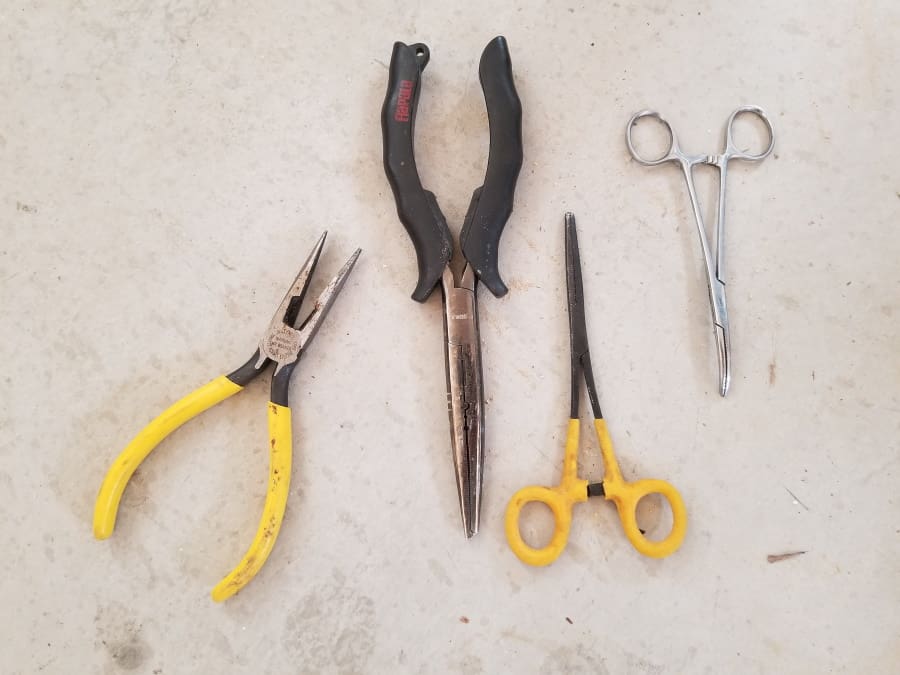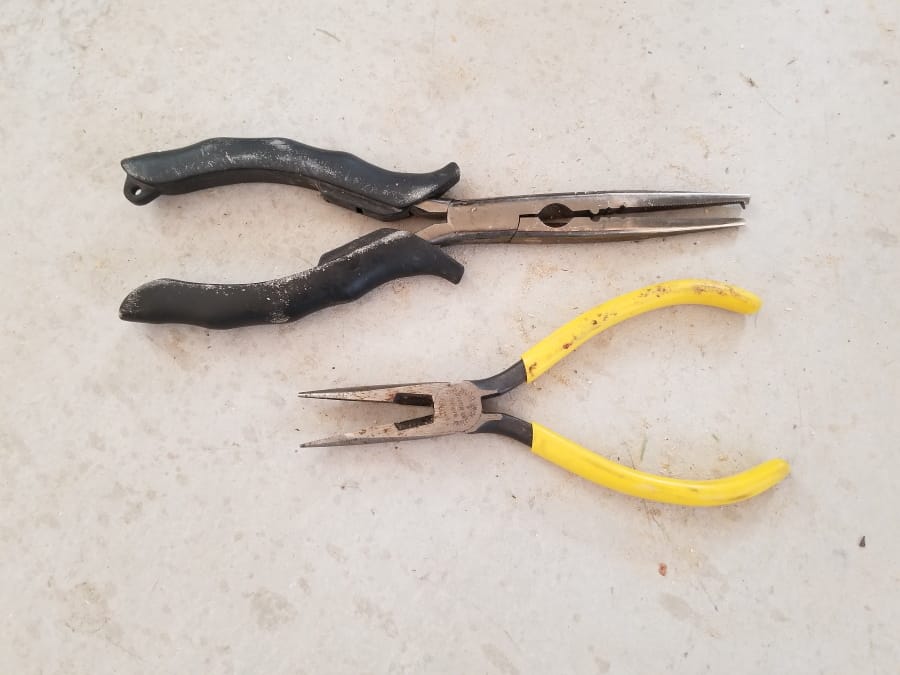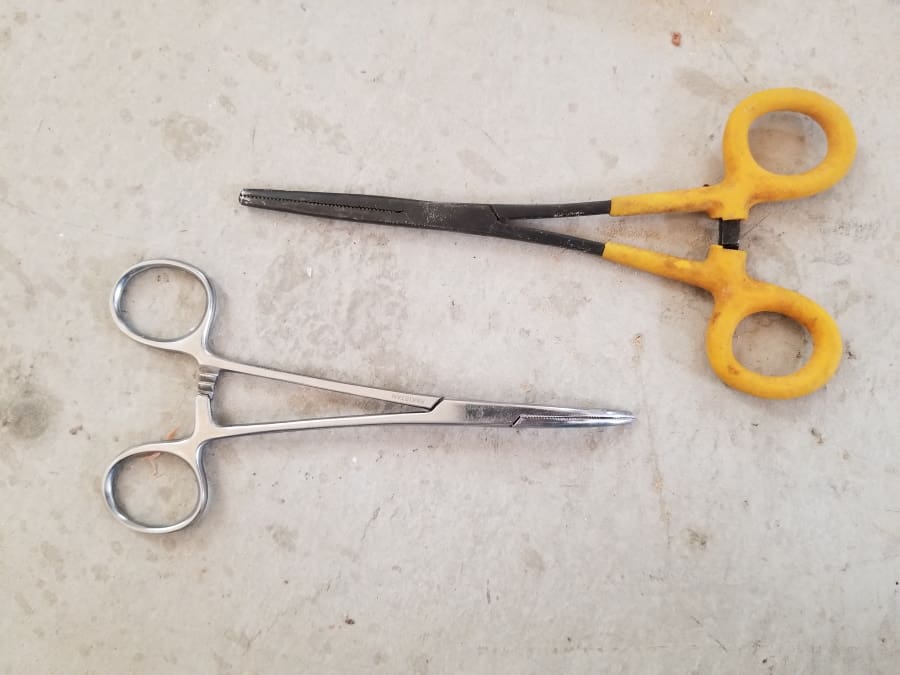Both fishing pliers and forceps are an integral part of fishing, but some may not know under which circumstances the use of either tool would be appropriate. Maybe you’re just a beginner, or perhaps it has been a while since you’ve been fishing, and your first child or grandchild is now old enough to be taken out onto the lake. Whatever the reason, I’m here to help you distinguish the difference, so let’s get right into it.

What is the difference between fishing pliers and forceps? The main difference is their durability and design, not necessarily what they are used for. But there are times that many might prefer one tool over the other for certain things like removing hooks, bending wires, and cutting lines.
And luckily, there are different kinds of forceps and pliers. Depending on what you are comfortable with using or spending your money on, there are many different designs and materials that you might consider when needing a specific task done. Which I’ll lay out clearly here for you:
The Distinction Between Fishing Pliers and Forceps
Whether you find pliers or forceps easier to work with, they’re both used often when fishing. Here are some of the things that they’re commonly used for:
Forceps
- Removing hooks from a fish’s mouth
- Crimping barb on a hook
- Squeezing a split shot on a leader
- Cutting line
Pliers
- Removing hooks from a fish’s mouth
- Bending wires
- Changing split rings
- Cutting line
Despite both having the ability to be used for the same things, it might also be useful to consider what else they are used for when deciding if you would prefer one over the other if not having both available on you.
Pliers
Mechanics, engineers, and electricians use needle nose pliers when working with wires. For the wires that need to be held in place or bent, these are always the right tools for the job. Jewelers will also use this tool when the beads, chains, and clasps are too small for their fingers. Pliers can squeeze, attach and tighten various pieces of jewelry with a firmer grip.
Forceps
Outside of the fishing world, forceps are used in the medical field. They are used during surgeries when surgeons are unable to use their hands to grasp onto specific parts of the body. They are also used when a baby is being delivered.
Pliers Materials and Forceps Styles
Not only are the forceps and pliers based on preference, but so are the styles of how they are made and what exactly they are made of:
Pliers

- Aluminum – It is corrosion-resistant, but the make of it is a lot softer compared to the other materials
- Stainless Steel – This one is good for cutting mono and braid, but after a while, it might start to suffer some minor corrosion along the surface of it. Forceps are also made of stainless steel.
- Titanium – It is costly, but will last you a lifetime. Titanium is bulletproof; it’ll get any job done that you would need them for without suffering from corrosion. These are bound to be the only ones you’ll ever need to buy.
Forceps

- Non-serrated Tip – These kinds are easy to use for pinching barbs on flies in order to unbarb the hook. Aside from the tip, the rest of the jaw is serrated to offer a firmer grip when removing flies.
- Mitten Clamps – The only difference is that they do not have the scissor-like loops to put your fingers through. These are mainly used by those wearing gloves or mittens (hence the name). Other than that, they work all the same.
- Scissor-style – Also known as scissor clamps, they have scissor blades in the back of the jaw that is good when you need to cut mono, trim down yarn strike indicators, or trim a fly. But remember to be careful when releasing fish, or else you might cut your leader or tippet.
As you can clearly see, despite how similar they are in use, there are plenty of different varieties of both tools that you can make use of for various different tasks whether big or small. It all depends on your preference and the brand that they are. Aside from the pliers and the forceps there are two more specific tools that I would like to talk a little about called a nipper and a disgorger because they too can be used for similar reasons.
Disgorger
Also called an unhooker or a hook remover, this tool is used to de-hook a fish’s mouth whenever it is impossible to use your fingers. And how the pliers and the forceps are generally used on bigger fish, a discorger is typically used on smaller fish. A discorger is typically made of plastic or metal.
You use it by slipping the end over a taut line and sliding it down to the base of the hook. Then you will need to push it in order to get it when the hook tightens against the discorger. Then the hook is finally out, safe, and secure. A discorger is said to work even if you can’t see the hook in the fish’s mouth.
Nipper
This a fourth tool I wanted to throw in the mix, so that you know that it is out there. A nipper is a multipurpose tool that can cut, sharpen, and thread hooks and lines. It can also remove glue and paint from the eye of a hook.
A nipper has a hardened edge that stays sharp for reliable cutting. There is a built-in magnet that holds flies while replacing the tippet. And the threader, along with the part that cleans the eye of the hook easily slides out and rotates whenever you need to use it, then retracts whenever you do not.
Nippers are usually compared to scissors or pliers, which was why I thought it necessary to bring it up along with this topic. For requirements outside of fishing, nippers are used for removing or “nipping” small amounts of hard material like tiles that might need to be squeezed in somewhere of an irregular shape like the corner of a stove or around the foot of a tub.
Other Essential Fishing Tools and Their Uses
There are many things that can be utilized when fishing, and I know that as a beginner, you might not be able to keep track of all the necessary tools you will need the first few times you go. So I compiled a list here of all the things you should remember to take with you whenever you are thinking about fishing:
- Fishing License – Each state requires them and they can also dictate which fish you are allowed to catch. You will most likely have to renew them every year. You can be fined and possibly have your equipment confiscated if caught fishing without a license.
- Tackle box – Always important to have one of these whenever you go out fishing. How else would you carry all of your tools to your favorite fishing spot?
- Zingers – Also known as a retractor, these are retractable lanyards that can hook onto your vest or gear bag and it is to help keep your fly fishing tools accessible. My lanyard has a spring clip I attach to a belt loop or jacket zipper.
- First Aid Kit – For those just-in-case times when you accidentally get stuck by the hook or maybe feel a headache coming on from being in the hot sun all day. For those moments, it is always good to keep a first aid kit handy.
- Matches – These are of good use in the case that you stuck out at night or lost. Use them for warmth and to give out signals to rescuers if you can’t find your way back.
- Flashlight – In case you end up staying a little later than planned. You’ll be able to see to take the hook out of that last fish you landed plus more easily navigate your way back to the car. With that in mind, keep extra batteries on hand also.
- Compass – If you really do get lost, and especially if you’re by yourself.
- Rod – Can’t fish without a rod, unless you would like to try handlining or noodling, which in that case you might as well leave the rest of this list alone.
- Gloves – In case noodling sounded like a good idea or to keep your hands warm when fishing at cooler times of the year.
- Swivels – To keep your line untwisted when retrieving it.
- Hooks – Remember to carry hooks of various sizes for the various sized fish. It is also better to know what type of fish is in the water before you decide which tactics you’ll be using.
- Bait – Whether real or fake, there are plenty of bait varieties that will be sure to entice the fish.
- Lures – For when you think that the bait won’t be enough, you can add some extra “character” to it by attaching some of these to your line.
- Bobbers – So you know when a fish is biting, and you can reel that sucker in. The bobbers do have an impact on how you cast your line, though, so be mindful when choosing which one you use.
- Sinkers – Because a hook and a worm are just not enough to take the leader down far enough, so you’ll need some extra weight. They are traditionally made of lead, but you can also find brass, tungsten, steel, or bismuth for the sake of the environment.
- Fishing line – Whether it is monofilament, fluorocarbon or braid, you never know when you are gonna need more.
I’m sure there are other things that you could take with on your fishing trips, but these are the main things that I know will be necessary at some point or other. But speaking of fishing lines, I do believe that it is important to know which kind best suits your situation. Let us take a look at them in more detail:
Braid
The quality of the braid is dependent solely on the number of weaves per inch. It is round in shape and offers strength and limpness that is soft like mono but as durable as rope, although many have low durability and can be cut easily by sharp rocks in the water. The other offset for some fishermen is that it has very little elasticity, which might accidentally go straight through the fish’s mouth if it pulls too hard or possibly break the rod.
An upside to the lack of stretch is that it is good for fishing in the grass, around lily pads, or making long casts. By adding a mono or fluoro leader, you can give it a little stretch so the fish can’t easily shake the hook. Braided line is more visible in the water which is less likely to attract fish unless you have a nicer looking leader (like fluoro) and bait.
Braided line can be a bit abrasive on the skin and can leave marks on your finger. It is also great for spinning reels and higher graded bait casters. Lastly, it floats well on top of the water.
Monofilament
The most common of the three lines, mono is great for beginners as far as casting, and line management is concerned. It is more abundant in diameter and offers a lot of elasticity to it, but in some cases, it can sometimes lead to missed hook-sets and lost fish. The thickness also reduces casting distance and leaves it susceptible to being tampered by the wind or heavy water currents. It is also a bit more challenging to pull it through weeds.
The diameter of the monoline is a bit more visible to the fish compared to fluoro. The amount of elasticity it has also rendered it to be less sensitive, making subtle bites a bit more challenging to distinguish. However, its stretchiness keeps fish from breaking off as easily. Mono does have a lot of memory, which means you’d need added care in order to keep it from turning into a “rat’s nest”.
Mono also needs to be replaced more often since it is out in the sun and constantly thrown in the water can really wear it down faster than the other lines. Because mono floats, it is perfect for topwater lures. It is also abrasion-resistant and good when in areas of dense wood or rock covering.
Fluorocarbon
These may look like a monoline, but they are not made of the same material. Fluoro is basically invisible in the water since it refracts light and is thin in diameter. It combines both braid and mono however in its elasticity, as it is not as stretchy as the mono, but it is more than the braided line. The stretching is more controlled, though, since it does take a bit of force to get it to stretch.
Another major difference is that the line sinks into the water rather than floating on top as the other two lines do. Fluoro overall is pretty versatile, it has good sensitivity and is resistant to abrasions. No wonder it is becoming more popular.
Unlike the other two lines though, it is waterproof. So, its strength, sensitivity, and resistance are the same below water as it is above, but you do have to wet the knot when tying it or else it will not work. Also, because it sinks to the bottom, it would be foolish to use topwater lures. Fluoro has great memory and must be handled with care so it does not kink up.
In short, the braid is great when casting at long distances, but is not resistant to abrasion. Mono is resistant to abrasion but is more visible and less sensitive to bites. Fluorocarbon, however, is invisible, but you need to make sure it doesn’t get all tangled up.
Picking Out the Right Pliers
When deciding which pliers are best for you and the sort of line you are using, there are some things you should consider. The very first thing is versatility. Many fishing pliers are able to trim and cut any kind of fishing line along with being able to crimp for making joins and being able to remove hooks.
There are pliers with springy handles to make them easier to use. The springs are considered vital if you plan on using them frequently, they will help lessen the chance of fatigue. Consider, too, the length of the nose, the more narrow it is, the more comfortable it will be able to remove deep hooks. A longer nose is good for larger fish.
The side cutters on pliers are also something you should look at before buying for cutting really strong wire and even hooks. Although the majority of fishing pliers have the line cutters on the side that allow you to cut different types of lines. There are also pliers that come with a split ring tool to help you open a split ring easier. It is just a small hook at the end of the pliers.
The second thing you should consider is how easily it can be used and transported – how accessible are they going to be when you need to reach for them. The lightness of weight and ease of usability will make the trip a lot better. Ones with a cover and lanyard are a better option if you’re going to be on a boat in the middle of the water.
I’m a firm believer in using/having the right tool for the right job and recommend (and have) a couple types of each pliers and forceps. For most of my fishing I use my smaller locking forceps that I keep clamped on my nipper’s lanyard. I mostly fish for trout and smaller panfish and the smaller forceps are easier for me to use for holding and tying the smaller hooks as well as releasing those smaller fish. Keeping the forceps clamped “at the ready” makes it easy to reach for when I’ve landed a fish – less fumbling around trying to find the tools I need!
Happy Fishing!
